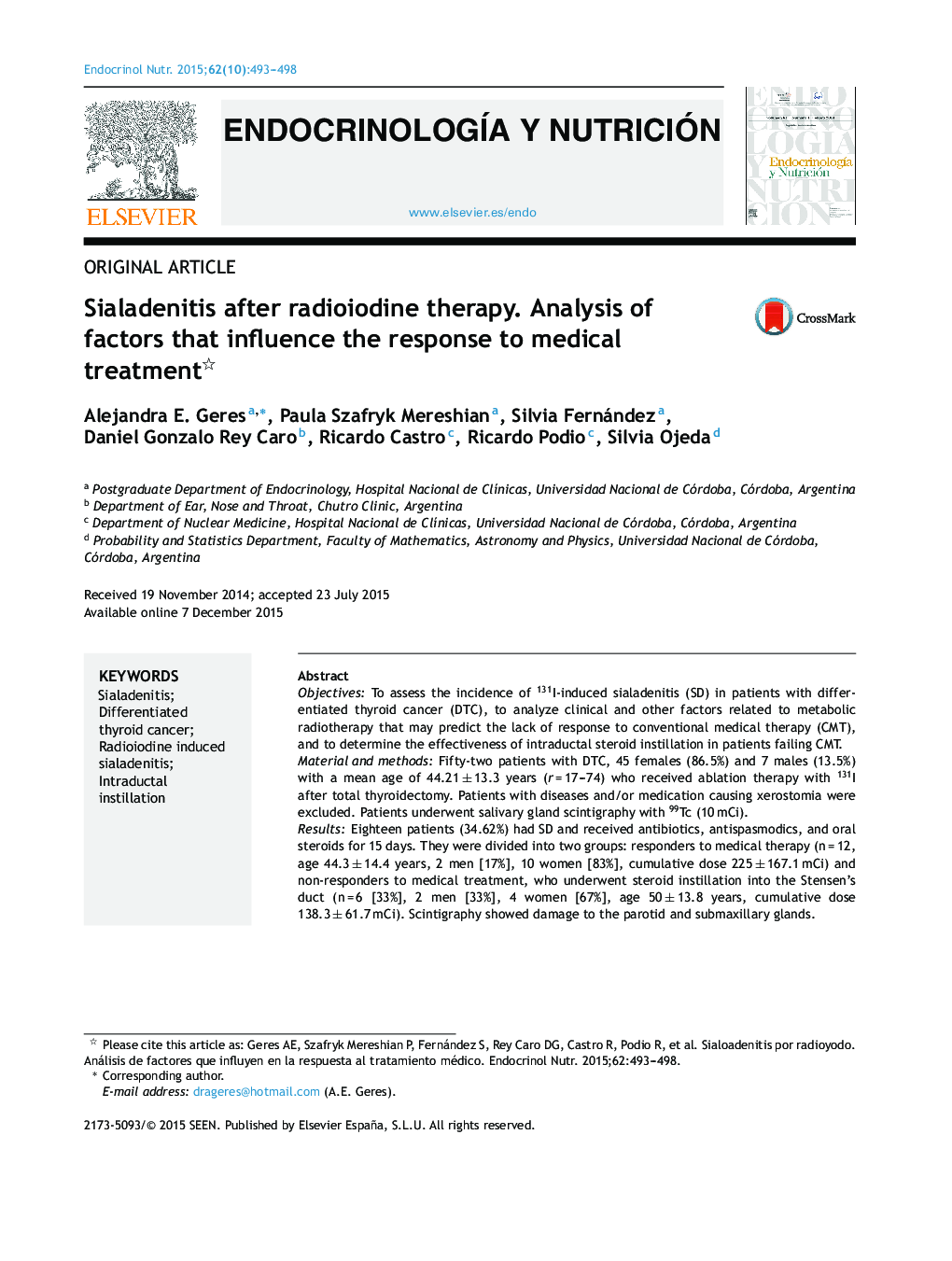| Article ID | Journal | Published Year | Pages | File Type |
|---|---|---|---|---|
| 3266834 | Endocrinología y Nutrición (English Edition) | 2015 | 6 Pages |
ObjectivesTo assess the incidence of 131I-induced sialadenitis (SD) in patients with differentiated thyroid cancer (DTC), to analyze clinical and other factors related to metabolic radiotherapy that may predict the lack of response to conventional medical therapy (CMT), and to determine the effectiveness of intraductal steroid instillation in patients failing CMT.Material and methodsFifty-two patients with DTC, 45 females (86.5%) and 7 males (13.5%) with a mean age of 44.21 ± 13.3 years (r = 17–74) who received ablation therapy with 131I after total thyroidectomy. Patients with diseases and/or medication causing xerostomia were excluded. Patients underwent salivary gland scintigraphy with 99Tc (10 mCi).ResultsEighteen patients (34.62%) had SD and received antibiotics, antispasmodics, and oral steroids for 15 days. They were divided into two groups: responders to medical therapy (n = 12, age 44.3 ± 14.4 years, 2 men [17%], 10 women [83%], cumulative dose 225 ± 167.1 mCi) and non-responders to medical treatment, who underwent steroid instillation into the Stensen's duct (n = 6 [33%], 2 men [33%], 4 women [67%], age 50 ± 13.8 years, cumulative dose 138.3 ± 61.7 mCi). Scintigraphy showed damage to the parotid and submaxillary glands.ConclusionIncidence of 131I-induced sialadenitis was similar to that reported by other authors. Age, mean cumulative dose of 131I, and involvement of parotid and submaxillary glands did not condition response to CMT; however, male sex was a conditioning factor. Symptom persistence for more than 15 days makes instillation into the Stensen's duct advisable. This is an effective and safe method to avoid surgical excision of salivary glands.
ResumenObjetivosEstudiar la incidencia de sialoadenitis (SD) por 131I en pacientes con cáncer diferenciado de tiroides (CDT), analizar los factores clínicos y otros vinculados a radioterapia metabólica que puedan predecir la falta de respuesta al tratamiento médico convencional (TMC) y determinar la eficacia de la instilación intraductal del Stenon (ITS) en pacientes con fracaso al TMC.Material y métodosCincuenta y dos pacientes con CDT, 45 mujeres (86,5%) y 7 hombres (13,5%), con edad media 44,21 ± 13,3 años, que postiroidectomía total recibieron dosis ablativa de 131I. Excluimos individuos con enfermedades/medicación causantes de xerostomía. Realizamos gammagrafía de glándulas salivales con 99Tc (10 mCi).ResultadosPresentaron SD 18 pacientes (34,62%) tratados con antibióticos, antiespasmódicos y corticoides vía oral durante 15 días. Se les dividió en 2 grupos: respuesta al tratamiento médico n = 12 (67%), edad 44,3 ± 14,4 años, 2 hombres (17%), 10 mujeres (83%), dosis acumulativa 225 ± 167 mCi; y sin respuesta al tratamiento médico, n = 6 (33%), a los que se instiló corticoides en conducto de Stenon; edad 50 ± 13,8 años, 2 hombres (33%), 4 mujeres (67%), dosis acumulativa 138,3 ± 61,7 mCi. Demostramos lesiones en la gammagrafía de glándulas parótidas y submaxilares.ConclusiónLa incidencia de sialoadenitis por 131I fue similar a la descripta por otros autores. La edad, la dosis media acumulada de 131I y la afectación de glándulas parótidas o submaxilares no condicionaron diferente respuesta al TMC, solo relacionada con el sexo masculino. La persistencia de síntomas durante más de 15 días hace recomendable la ITS de corticoides, método eficaz y seguro para preservar dichas glándulas ante otras opciones como la exéresis quirúrgica.
